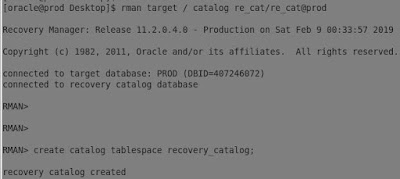Recovery Catalog Database Using RMAN - Karan Rajpoot
Recovery Catalog Database Using RMAN
By default, RMAN connects to the target database in NOCATALOG mode, meaning that it uses the control files in the target database as the sole repository of RMAN metadata. Perhaps the most important decision you make when using RMAN is whether to create a recovery catalog as the RMAN repository for normal production operations. A recovery catalog is a schema created in a separate database that contains metadata obtained from the target control file.
With the use of the recovery catalog database, you can put all the backup or pieces information of the multiple databases in a single location.
==> Benefits of Using the Recovery Catalog as the RMAN Repository
When you use a recovery catalog, RMAN can perform a wider variety of automated backup and recovery functions than when you use the control file in the target database as the sole repository of metadata.
==>The following features are available only with a catalog
1) You can store metadata about multiple target databases in a single catalog.
2) You can store metadata about multiple incarnations of a single target database in the catalog. Hence, you can restore backups from any incarnation.
3) Resynchronizing the recovery catalog at intervals less than the CONTROL_FILE_RECORD_KEEP_TIME setting, you can keep historical metadata.
4) You can report the target database schema at a noncurrent time.
5) You can store RMAN scripts in the recovery catalog.
==> Steps to create a Recovery Catalog Database
Step 1) First to create a tablespace for the recovery catalog database to put the information.
Step 2) Next step is to create a recovery catalog user and assign tablespace which we have created in the first step.
Step 3) Grant the recovery_catalog_owner permission to the user.
Step 4) Connect to the RMAN to create the catalog database.
Step 5) Now Register the databases which will use this database as a recovery catalog.
Step 6) Configure the RMAN persistent parameters.
Step 7) Take the backup plus archivelog from below command.
Command: - backup database plus archivelog.
Step 8) You can also check how many databases are registered under the catalog database by using below command.
Note: - First you need to login to the catalog user.
View: - rc_database
Command: - select name,DBID,DB_KEY from rc_database;
Example: -
Thank you!!











Comments
Post a Comment